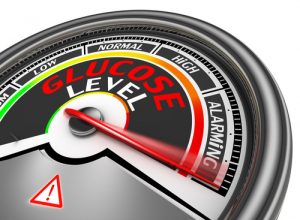What Does This Mean For Us?
Author: Dr. Stephen Chaney
 The increase of prediabetes and type 2 diabetes in the US adult population has been well documented. And these conditions have severe health consequences.
The increase of prediabetes and type 2 diabetes in the US adult population has been well documented. And these conditions have severe health consequences.
- Nearly 70% of people with prediabetes will go on to develop type 2 diabetes.
-
- Without a change in lifestyle and/or medical intervention, many people with prediabetes develop type 2 diabetes within 5 years.
- Type 2 diabetes is highly correlated with increased risk for heart disease and stroke, vision loss, kidney disease, nerve damage, and cognitive decline.
- And as we learned during COVID, diabetes suppresses the immune system, making us much more likely to die from viral infections ranging from flu to RSV and coronaviruses like SARS-CoV-2.
Because both prediabetes and type-2 diabetes are highly correlated with obesity, the US Preventative Services Task Force has recently recommended regular screening of adults aged 35-70 who are overweight or obese for prediabetes and type-2 diabetes.
But what about our teenagers? Are they at risk? Should they be screened also? Recent reports have documented an alarming increase in overweight and obesity in this population group.
The prevalence of type-2 diabetes is low in this group, but previous studies have reported that approximately 1 in 5 US teenagers have prediabetes. Is this a ticking time bomb that will affect their health as adults? More importantly, is the prevalence of prediabetes getting worse, just as it is for the adult population?
The expectation is that the prevalence of prediabetes in US teens is increasing, just as it is for US adults. But scientists and health organizations like the Preventive Services task force require hard data, not just expectations.
So, the study (J Liu et al, JAMA Prediabetes, 176: 608-610, 2022) I will describe today was designed to determine the prevalence trend over the past 20 years for prediabetes in US teenagers.
How Was The Study Done?
 The study used data from the NHANES database from 1999 to 2018. NHANES (National Health and Nutritional Examination Survey) is a program administered by the CDC that collects health and nutrition information from adults and children in the United States on a biennial basis.
The study used data from the NHANES database from 1999 to 2018. NHANES (National Health and Nutritional Examination Survey) is a program administered by the CDC that collects health and nutrition information from adults and children in the United States on a biennial basis.
Among the data collected are demographic information (sex, age, race, economic status, etc.), physical exam information (BMI, blood chemistry, etc.), and health information (prediabetes, diabetes, etc.).
To have enough participants in each time period for statistically significant results, the data were combined for each two consecutive 2-year surveys. (For example, the 2000-2001 and 2001-2002 NHANES surveys were combined into a single dataset from 1999 to 2002.)
The time periods included in this study were 1999-2002, 2003-2006, 2007-2010, 2011-2014, and 2015-2018. A total of 6598 teenagers were included in this study, for an average of around 1,300 per time-period.
The main comparison was prediabetes prevalence among US teens in each time period. The study also looked at the effect of obesity and various sociodemographic classifications on prediabetes prevalence in teens.
Are Our Teens Getting Sicker?
 When the 2015-2018 time period was compared to the 1999-2002 time period, the prevalence of prediabetes:
When the 2015-2018 time period was compared to the 1999-2002 time period, the prevalence of prediabetes:
- Increased from 11.6% to 28.2% – a 2.43-fold increase.
When broken down by age groups, the increase was:
- 2.35-fold for ages 12-15.
- 2.56-fold for ages 16-19.
When broken down by gender, the increase was:
- 2.76-fold for females.
- 2.30-fold for males.
When broken down by race and ethnicity, the increase was:
- 2.10-fold for Hispanics.
- 2.76-fold for Blacks.
- 2.33-fold for Whites.
None of these differences were statistically significant, but they might have been had the sample size been larger.
In short, there has been more than a 2-fold increase in the prevalence of prediabetes in US teenagers over the last 20 years. And this increase was seen in young teenagers, older teenagers, male and female teenagers, and in every racial and ethnic category surveyed.
Why Is Prediabetes Increasing In Our Teens?
 Knowing the trend is important. But if you want to reverse the trend, it’s much more important to know what is causing it.
Knowing the trend is important. But if you want to reverse the trend, it’s much more important to know what is causing it.
Of course, obesity is an obvious villain. Obesity is highly associated with prediabetes and type 2 diabetes, and we know that obesity is increasing in our teens. The data from this study suggests that obesity may contribute to the increase in prediabetes prevalence. But it’s not likely to be the sole cause.
For example:
- Obesity in our teens has only increased 1.3-fold over the last 20 years.
- More importantly, the difference in prediabetes prevalence between normal weight and overweight teens was not significant in this study.
The authors of this study also found no significant effect of educational level of the parents, family income level, or food security on the increased prevalence of prediabetes prevalence in teens.
So, what else might be contributing to the increased prevalence of prediabetes in our teens? I have two suggestions:
- Decreased physical activity. Teens today are spending more hours staring at screens and less time exercising. Lack of exercise contributes to obesity, but there is also emerging evidence that it may independently contribute to diseases like prediabetes and diabetes.
- Increased junk food consumption. Teenager’s diets have never been great, but multiple studies have shown that consumption of highly processed food has skyrocketed over the past 20 years.
Obviously, more work needs to be done on proving the causes of increased prediabetes prevalence in our teens, but we know enough already to start making some needed changes.
What Does This Study Mean For Us?
 If you are a parent or grandparent, this study is a wake-up call. It’s not that we didn’t already suspect it was happening. After all, the increasing prevalence of type 2 diabetes in young US adults had to come from somewhere.
If you are a parent or grandparent, this study is a wake-up call. It’s not that we didn’t already suspect it was happening. After all, the increasing prevalence of type 2 diabetes in young US adults had to come from somewhere.
But this study makes it clear that prediabetes is increasing at an alarming rate in our teenage children (and grandchildren). This is a ticking time bomb.
As I said above, prediabetes leads to diabetes. And diabetes leads to heart disease and other debilitating diseases. Unless we reverse this trend, we may be dooming our teens to poor health and a shortened lifespan as adults.
So, the important questions become, “What can we do about it?” and “What can we do to reverse this trend?”
The top three things we can do are clear. We need to encourage our teens to:
- Exercise more. Only 1 in 4 high school students get the recommended amount of daily activity.
- Eat a healthier diet. Today more than 2/3 of the calories our teens consume come from ultraprocessed foods.
And we know the changes they need to make. Previous studies have shown that whole food, primarily plant-based diets reduce the risk of developing prediabetes and type 2 diabetes and can even reverse both conditions as effectively as medications.
- Maintain a healthier weight. The prevalence of obesity in our teens has increased dramatically in the last 40 years. Of course, the secret is that if they get the diet and exercise part right, weight control is much easier.
But none of these changes are easy. This can’t be a, “Do as I say, not as I do” change. This needs to be a whole family change. We need to set the example.
Of course, I know some teens like to rebel against anything their parents do or recommend. We had a teenager once.
Setting the example doesn’t necessarily mean they will accept it right away. But with time they may come around. They are listening to what you say and watching what you do even when they are doing the opposite.
And I can guarantee if you aren’t willing to make these changes, they won’t be either.
The Bottom Line
A recent study looked at the prevalence of prediabetes in US teenagers over the past 20 years. The results were alarming.
- The prevalence of prediabetes in US teens has more than doubled over the past 20 years.
- In 2018, the last year in this study, the prevalence of prediabetes was in the 25-30% range.
- The increased prevalence of diabetes was independent of gender, income, food security, ethnicity, and education level of the parents.
If you are a parent or grandparent, this is a ticking time bomb because 70% of people with prediabetes go on to develop type 2 diabetes within the next 5 years. And type 2 diabetes dramatically increases the risk of heart disease, stroke, kidney disease, vision loss, and cognitive decline. We may be dooming our teens to poor health and a shortened life span as adults.
For more details about this study, the causes of the increased prevalence of prediabetes in teens, and what you can do to reverse this trend for your teens, read the article above.
These statements have not been evaluated by the Food and Drug Administration. This information is not intended to diagnose, treat, cure, or prevent any disease.
_____________________________________________________________________________
My posts and “Health Tips From the Professor” articles carefully avoid claims about any brand of supplement or manufacturer of supplements. However, I am often asked by representatives of supplement companies if they can share them with their customers.
My answer is, “Yes, as long as you share only the article without any additions or alterations. In particular, you should avoid adding any mention of your company or your company’s products. If you were to do that, you could be making what the FTC and FDA consider a “misleading health claim” that could result in legal action against you and the company you represent.
For more detail about FTC regulations for health claims, see this link.
https://www.ftc.gov/business-guidance/resources/health-products-compliance-guidance
_____________________________________________________________________
About The Author
 Dr. Chaney has a BS in Chemistry from Duke University and a PhD in Biochemistry from UCLA. He is Professor Emeritus from the University of North Carolina where he taught biochemistry and nutrition to medical and dental students for 40 years. Dr. Chaney won numerous teaching awards at UNC, including the Academy of Educators “Excellence in Teaching Lifetime Achievement Award”. Dr Chaney also ran an active cancer research program at UNC and published over 100 scientific articles and reviews in peer-reviewed scientific journals. In addition, he authored two chapters on nutrition in one of the leading biochemistry text books for medical students.
Dr. Chaney has a BS in Chemistry from Duke University and a PhD in Biochemistry from UCLA. He is Professor Emeritus from the University of North Carolina where he taught biochemistry and nutrition to medical and dental students for 40 years. Dr. Chaney won numerous teaching awards at UNC, including the Academy of Educators “Excellence in Teaching Lifetime Achievement Award”. Dr Chaney also ran an active cancer research program at UNC and published over 100 scientific articles and reviews in peer-reviewed scientific journals. In addition, he authored two chapters on nutrition in one of the leading biochemistry text books for medical students.
Since retiring from the University of North Carolina, he has been writing a weekly health blog called “Health Tips From the Professor”. He has also written two best-selling books, “Slaying the Food Myths” and “Slaying the Supplement Myths”. And most recently he has created an online lifestyle change course, “Create Your Personal Health Zone”. For more information visit https://chaneyhealth.com.
For the past 45 years Dr. Chaney and his wife Suzanne have been helping people improve their health holistically through a combination of good diet, exercise, weight control and appropriate supplementation.














